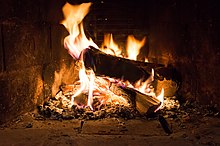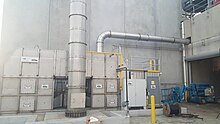Definition and Characteristics of Combustion
– Combustion is a high-temperature chemical reaction between a fuel and an oxidant.
– It is an exothermic reaction that produces oxidized products, often in the form of smoke.
– Combustion can result in the formation of a visible flame.
– Activation energy is required to initiate combustion, but a flame can sustain the reaction.
– Combustion can be a complex sequence of radical reactions.
Types of Combustion
– Complete combustion occurs when a reactant burns in oxygen and produces carbon dioxide and water.
– Incomplete combustion occurs when there is insufficient oxygen, leading to the production of carbon monoxide and carbon.
– Pyrolysis, a process of thermal decomposition, often precedes combustion in fuels like diesel oil, coal, or wood.
– Incomplete combustion can result in the release of noxious particulate matter and gases.
– Combustion devices, such as burners and internal combustion engines, can be designed to improve the quality of combustion.
Oxidants for Combustion
– Common oxidants for combustion include atmospheric or pure oxygen, chlorine, and fluorine.
– Hydrogen burns in chlorine to form hydrogen chloride, releasing heat and light.
– Combustion can be catalyzed by substances like platinum or vanadium.
– Nitrogen, although not considered a combustible substance, can form nitrogen oxides during combustion.
– Combustion in air, which contains nitrogen, can also produce small amounts of nitrogen oxides.
Environmental Impact of Combustion
– Combustion in air can create nitrogen oxides (NOx), which contribute to air pollution.
– Complete combustion is difficult to achieve, leading to the production of toxic smoke and unburned or partially oxidized products.
– Fuel gas cleaning or catalytic converters may be required by law to reduce emissions from combustion processes.
– Combustion of fossil fuels and renewable fuels is a major source of energy for cooking, electricity production, and heating.
– Combustion is also used for waste incineration, both nonhazardous and hazardous.
Measurement and Analysis of Combustion
– Combustion analyzers are used by HVAC contractors, firefighters, and engineers to test the efficiency of burners and internal combustion engines.
– The efficiency of vehicles can be measured through combustion analysis.
– Carbon monoxide is one of the byproducts of incomplete combustion and can be measured during analysis.
– Test equipment helps in analyzing the degree of combustion and improving combustion quality in devices.
– Environmental legislation requires the use of after-burning devices, such as catalytic converters, to meet emission standards. Source: https://en.wikipedia.org/wiki/Combustion
Combustion, or burning, is a high-temperature exothermic redox chemical reaction between a fuel (the reductant) and an oxidant, usually atmospheric oxygen, that produces oxidized, often gaseous products, in a mixture termed as smoke. Combustion does not always result in fire, because a flame is only visible when substances undergoing combustion vaporize, but when it does, a flame is a characteristic indicator of the reaction. While activation energy must be supplied to initiate combustion (e.g., using a lit match to light a fire), the heat from a flame may provide enough energy to make the reaction self-sustaining.


Combustion is often a complicated sequence of elementary radical reactions. Solid fuels, such as wood and coal, first undergo endothermic pyrolysis to produce gaseous fuels whose combustion then supplies the heat required to produce more of them. Combustion is often hot enough that incandescent light in the form of either glowing or a flame is produced. A simple example can be seen in the combustion of hydrogen and oxygen into water vapor, a reaction which is commonly used to fuel rocket engines. This reaction releases 242 kJ/mol of heat and reduces the enthalpy accordingly (at constant temperature and pressure):
Uncatalyzed combustion in air requires relatively high temperatures. Complete combustion is stoichiometric concerning the fuel, where there is no remaining fuel, and ideally, no residual oxidant. Thermodynamically, the chemical equilibrium of combustion in air is overwhelmingly on the side of the products. However, complete combustion is almost impossible to achieve, since the chemical equilibrium is not necessarily reached, or may contain unburnt products such as carbon monoxide, hydrogen and even carbon (soot or ash). Thus, the produced smoke is usually toxic and contains unburned or partially oxidized products. Any combustion at high temperatures in atmospheric air, which is 78 percent nitrogen, will also create small amounts of several nitrogen oxides, commonly referred to as NOx, since the combustion of nitrogen is thermodynamically favored at high, but not low temperatures. Since burning is rarely clean, fuel gas cleaning or catalytic converters may be required by law.
Fires occur naturally, ignited by lightning strikes or by volcanic products. Combustion (fire) was the first controlled chemical reaction discovered by humans, in the form of campfires and bonfires, and continues to be the main method to produce energy for humanity. Usually, the fuel is carbon, hydrocarbons, or more complicated mixtures such as wood that contain partially oxidized hydrocarbons. The thermal energy produced from the combustion of either fossil fuels such as coal or oil, or from renewable fuels such as firewood, is harvested for diverse uses such as cooking, production of electricity or industrial or domestic heating. Combustion is also currently the only reaction used to power rockets. Combustion is also used to destroy (incinerate) waste, both nonhazardous and hazardous.
Oxidants for combustion have high oxidation potential and include atmospheric or pure oxygen, chlorine, fluorine, chlorine trifluoride, nitrous oxide and nitric acid. For instance, hydrogen burns in chlorine to form hydrogen chloride with the liberation of heat and light characteristic of combustion. Although usually not catalyzed, combustion can be catalyzed by platinum or vanadium, as in the contact process.

